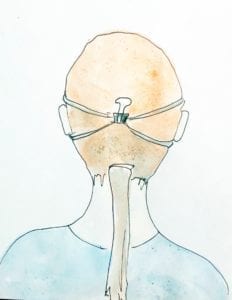As reported in CCAKids Blog, 2020’s contagion has imposed a strange new set of rules and precautions for leaving the house. The latest CDC recommendation has told all of America to wear a mask when out of the house to protect oneself from catching COVID-19 or spreading it to others.
Finding a well fitting mask can be difficult for some though- Children’s Craniofacial Assocation (CCA), reminds us that heads can come in all shapes and sizes. They explain that for some of their community members, the typical masks may be inaccessible due to the elastic straps that rest on the ears, which may interfere with hearing aids, BAHA hearing aids, prosthetic ears, or lack of ears. For these people, there must be another way to have a mask that is accessible, since leaving the house now and socializing at any distance requires such face coverings. To respond to this, CCA has created a video to demonstrate their method of creating a face covering that ties behind the head with two sets of thin strips of fabric that lace together like draw strings.
CCA explains this is just one of the options. There is also a prefabricated mask which loops over the ear without making contact with them. Rather they are supported with a paper clip, string, ribbon, or a piece of elastic, to create tension to hold the two sides together behind the head. There’s a related option that uses the same principle, but using a short strap with two buttons to loop the two elastic straps on behind the head.
When the masks are on, it’s important to remember that the protective masks need to be sanitized too to make them effective. This includes washing the mask before and after use in hot soapy water as well as your hands before handling the mask and putting it on your face. Once the mask is on, it needs to stay on without any contact with your hands. This means not touching your face or making adjustments to the mask so that the face remains a clean, sterile space. If you need to adjust it, you can use a clean sterile barrier such as a fresh paper towel, nitrile glove, or tissue.
Finally, this is not direct medical advice and any personal decisions should be made with the assistance of a doctor or medical professional first. This is simply an extra how-to on one way to stay safe and maintain some freedom with the help of protective action.
CCA wrote,
“We are in this together. No one will be left behind! We all deserve access to the things of life that we need to survive and thrive.”









